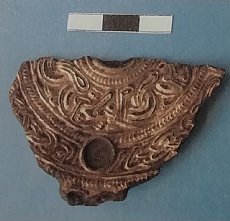Anglo-Saxon mount from Dornoch
02 October 2019
- News Type:
- Find of the Month

Metal detecting in the area of Dornoch over the years has produced a great number of objects which have ranged in date from prehistory through to the modern day. In 2005, one of the more exceptional finds from the area was reported to Treasure Trove: a decorated Anglo- Saxon style gilded copper-alloy disc mount. Only approximately one third of the circular object was represented but it was very well preserved. It measures 56.4 x 37.5mm with the diameter of the rim boss 8.4mm and the diameter of central boss 5mm. It is decorated with chip-carved, interlocking, backwards biting beasts around the central boss and narrower, more ambiguous zoomorphic interlace around the outside, with imitation beaded filigree between and outside of these. The single surviving setting was empty.
The decoration of the running interlocking beasts is similar to that found on Anglo-Saxon metalwork and manuscripts. An almost identical disc mount comes from Allington Hill, Cambridgeshire (now in the Ashmolean Museum), the decoration of which differs only in that the borders comprise three raised concentric circles with alternating zones of dots, whilst the Dornoch mount’s border is more rope like. The Allington hill mount also has raised dots along the jaws of the beasts, a feature that the Dornoch mount lacks.
The Dornoch mount has been identified as a seventh century Style II mount and may have been used as part of harness fittings for a horse. It is one of only a small amount of Anglo-Saxon metal work found on the northern Pictish mainland. Alice Blackwell identified in her 2018 thesis 18 objects from ten locations, found across Aberdeen, Moray, Inverness, Easter Ross, Caithness, and Highland. Many, like the Dornoch mount, are stray finds from metal detecting, but some come from contexts associated with forts, Viking graves, a hoard and the monastic settlement at Portmahomack. This regional assemblage is small, but it is significant as Anglo-Saxon finds are rare in northern Britain.
The Northumbrian kingdom reached as far as the Edinburgh area until 973, bringing new traditions of metalwork, manuscripts and church sculpture from the south. The exotic metalwork was probably traded north to Pictish chiefs. There were also clearly links to the monastery at Portmahomack as shown by styles of carving and the presence of a Northumbrian coin. As a result there are secular and religious contexts to account for this metalwork in the north. The Dornoch mount is also particularly interesting as it provides a new example of the backward-biting motif from Scotland and demonstrates stylistic links between Anglo-Saxon and Insular metalwork.
The mount is on display at Inverness Museum and Art Gallery. Accession No. INVMG 2006.004.001.
Further Infromation:
Blackwell, A. 2018. A reassessment of the Anglo-Saxon artefacts from Scotland: material interactions and identities in early medieval northern Britain. PhD thesis, University of Glasgow (available online)
Treasure Trove Artefact Report 39/05 in Inverness Museum and Art Gallery archives.
Submitted by Grace Woolmer
Find of the Month Archive
- 25/07/2022 Steatite Vessels
- 10/04/2021 Cruisie lamp in Dunrobin Castle Museum
- 02/03/2021 Medieval Sword Pommel from Sleat, Skye
- 01/02/2021 Hilton of Cadboll Pictish Cross Slab
- 04/01/2021 Gunflint from Stoneyfield, Inverness
- 02/12/2020 Bobbin from Contin Bobbin Mill
- 02/11/2020 Russian Lead Cloth Seal from Cromarty
- 01/10/2020 The Poolewe Hoard
- 04/09/2020 Storr Rock Viking Silver Hoard
- 07/08/2020 Mesolithic bloodstone artefacts from Camas Daraich, Skye
